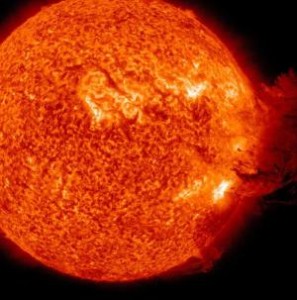Coronal Mass Ejection could destroy surface of the moon – Scientists
Wednesday, December 7th, 2011 12:50:52 by Taimoor Tariq
Coronal Mass Ejection could destroy surface of the moon – Scientists
In a surprising revelation, NASA scientists claim that solar storms caused by the Coronal Mass Ejection (CME) could cause erosion to the surface of the moon. This was claimed after a new set of computer simulations conducted by NASA scientists.
This could also result in atmospheric loss for planets like Mars that are not protected by a global magnetic field.
Rosemary Killen of NASA’s Goddard Space Flight Centre, Greenbelt is leading the research as head of the Dynamic Response of the Environment at the Moon (DREAM) which is a project of the NASA Lunar Science Institute.
CMEs are intense gust produced by a normal solar wind. These gusts diffuse a shower of electrically conductive gas plasma that Sun blows from its surface to outer space. Billion tons of plasma can be contained inside a strong SME and they move at around
million miles an hour.
Because of its tenous surroundings, moon is in the exosphere and is vulnerable to the effects of CME. The plasma from these gusts affect the lunar surface and the atoms on moon’s surface are ejected in a process known as ‘sputtering’.
"We found that when this massive cloud of plasma strikes the moon, it acts like a sandblaster and easily removes volatile material from the surface," said William Farrell, DREAM team lead at NASA Goddard. "The model predicts 100 to 200 tons of lunar material
— the equivalent of 10 dump truck loads — could be stripped off the lunar surface during the typical 2-day passage of a CME."
The effects of CME’s interaction with moon were never predicted before this research.
Intense heat, radiation or removal of electrons from the atoms in a gas create plasma. Due to its intense temperature, forms of free ions and the solar wind plasmas are emitted.
"Sputtering is among the top five processes that create the moon’s exosphere under normal solar conditions, but our model predicts that during a CME, it becomes the dominant method by far, with up to 50 times the yield of the other methods," says Killen,
lead author of a paper on this research appearing in a special issue of the Journal of Geophysical Research Planets.
NASA’s Lunar Atmosphere And Dust Environment Explorer (LADEE) — a lunar orbiter mission scheduled to launch in 2013 — will be able to test their predictions. The strong sputtering effect should kick lunar surface atoms to LADEE’s orbital altitude, around
20 to 50 kilometers (about 12.4 to 31 miles), so the spacecraft will see them increase in abundance.
Various research journals written by scientists at NASA and other observatories regarding threats posed to moon due to this will appear in the Journal of Geophysical Research Planets.
Tags: , cme, coronal mass ejection, NASA, rosemary killen, ScientistsShort URL: https://www.newspakistan.pk/?p=5640

















